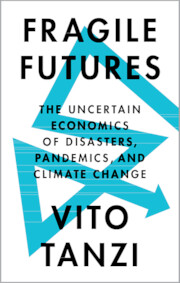Book contents
- Fragile Futures
- Fragile Futures
- Copyright page
- Contents
- Acknowledgments
- Epigraph
- Part I Uncertain Future Events and Reactions to Them
- Part II Pandemics and Other Disasters
- Part III Climate Change and Global Warming
- 11 When the Earth Became Man’s Private Property
- 12 Early Concerns about the Environment
- 13 From Environmental Concerns to Climate Change
- 14 From Climate Change to Global Warming
- Part IV Back to Some Theoretical Issues
- References
- Index
13 - From Environmental Concerns to Climate Change
from Part III - Climate Change and Global Warming
Published online by Cambridge University Press: 28 April 2022
- Fragile Futures
- Fragile Futures
- Copyright page
- Contents
- Acknowledgments
- Epigraph
- Part I Uncertain Future Events and Reactions to Them
- Part II Pandemics and Other Disasters
- Part III Climate Change and Global Warming
- 11 When the Earth Became Man’s Private Property
- 12 Early Concerns about the Environment
- 13 From Environmental Concerns to Climate Change
- 14 From Climate Change to Global Warming
- Part IV Back to Some Theoretical Issues
- References
- Index
Summary
Description: Some concerns about the environment began in the 1950s and 1960s. They were mainly directed at the impact of lead in the gasoline that cars used. These led to some regulation on car mileage. A marine biologist, Rachel Carson, in a bestselling book, Silent Spring, raised concerns about the pollution of springs and rivers, and about the environmental impact of dams. <break>An environmental movement came into existence, worried about the impact that growth would have on the future availability of some essential resources. This led to the Club of Rome and to the No-Growth Society. The EPA was created in the USA and the Clean Water Act was created in those years. President Nixon strongly endorsed a clean environment that he called a “crusade.” But the choice between jobs and a clean environment led to strong opposition to the environmental movement.<break>In the 1990s, the focus changed toward more dangers, such as the growing amount of carbon dioxide in the atmosphere and its impact on the world temperature. The concern became an existential one, as stressed by the Stern Review, by Vice President Gore’s An Inconvenient Truth, by UN Reports, and by NASA estimates of climate change. Global warming started to be seen as an existential threat. The issue could no longer be ignored.
Keywords
- Type
- Chapter
- Information
- Fragile FuturesThe Uncertain Economics of Disasters, Pandemics, and Climate Change, pp. 166 - 180Publisher: Cambridge University PressPrint publication year: 2022

